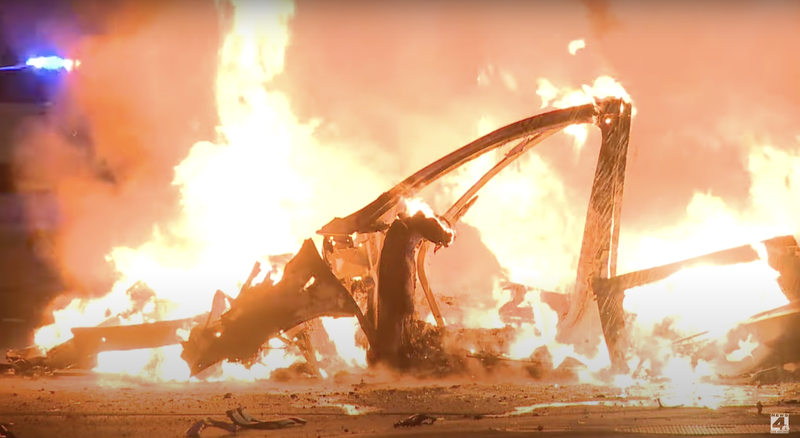Firefighters Still Aren't Sure How to Quickly Defeat EV Fires

Tens of thousands of gallons: That’s how much water it takes to extinguish a single electric vehicle fire. As EVs becomes more prevalent on our roads — possibly reaching 50 percent of all new car sales by 2030 — firefighters are still struggling to get proper training on how to quickly and effectively put out these incredibly intense blazes.
Vox did a deep dive into EV fires. The publication focused on Teslas, but that’s not really fair as all EVs have fire problems. It took General Motors several tries to remedy a fire problem with the Chevy Bolt, at one point instructing owners not to park their vehicles inside garages or near structures and to only charge their vehicles a certain amount. And these are cars that hadn’t even crashed. They’d just go up randomly.
Read more
When an EV goes up, it really goes, thanks to all the power stored in the battery. From Vox:
The first moments of an EV fire might appear relatively calm, with only smoke emanating from underneath the vehicle. But as thermal runaway takes hold, bright orange flames can quickly engulf an entire car. And because EV batteries are packed with an incredible amount of stored energy, one of these fires can get as hot as nearly 5,000 degrees Fahrenheit. Even when the fire appears to be over, latent heat may still be spreading within the cells of the battery, creating the risk that the vehicle could ignite several days later. One firefighter compared the challenge to a trick birthday candle that reignites after blowing it out.
Because EV fires are different, EV firefighting presents new problems. Firefighters often try to suppress car fires by, essentially, suffocating them. They might use foam extinguishers filled with substances like carbon dioxide that can draw away oxygen, or use a fire blanket that’s designed to smother flames. But because EV fires aren’t fueled by oxygen from the air, this approach doesn’t work. Instead, firefighters have to use lots and lots of water to cool down the battery. This is particularly complex when EV fires occur far from a hydrant, or if a local fire department only has a limited number of engines. Saltwater, which is extremely efficient at conducting electricity, can make the situation even worse.
Even when EV fires are eventually put out, they can reignite. Last year, a Tesla Model S caught fire at a junk yard weeks after being involved in a crash, Autoblog reports. Firefighters eventually pushed the whole thing into a water-filled pit to douse the flames.
While Vox’s headline may have unfairly targeted Tesla, some of the automaker’s fire issues are self-inflicted via “cool” design, rather than a matter of physics. The electric doorhandles on Teslas, for instance, are the subject of a lawsuit after a driver trapped in his burning Model S after a crash died. And in May of last year, a Tesla driver had to kick out his window in order to escape his burning vehicle after the car died, displayed an error message and began smoking, Reuters reports.
It doesn’t help that Tesla, which sell more EVs than any other car company in the U.S., isn’t exactly forthcoming in training materials and information for firefighters. From Vox:
In the long, wide-ranging message, McConnell also explained what assistance Tesla could and could not provide. He offered online training sessions but could not arrange in-person training because, McConnell explained, he had “just too many requests.” A diagram for the Model X implied there was magnesium in a part of the car that did not, in fact, contain magnesium. There was no extrication video guide for the company’s Model Y car (extrication is the firefighter term for removing someone from a totaled vehicle). It would be difficult to get a training vehicle for the Austin firefighters to practice with, McConnell added, since Tesla is a “build to order manufacturer.” Most of Tesla’s scrap vehicles are recycled at the company’s Fremont plant, he said, though a car could become available if one of Tesla’s engineering or fleet vehicles crashed.
McConnell’s long email reflects the current approach to fighting EV fires and the fact that fire departments across the country are still learning best practices. Even now, there isn’t consensus on the best approach. Some firefighters have considered using cranes to lift flaming EVs into giant tanks of water, although some automakers discourage submerging entire vehicles. Rosenbauer, a major fire engine and firefighting equipment manufacturer, has designed a new nozzle that pierces through the battery casing and squirts water directly onto the damaged cells, despite some official automaker guides that say firefighters shouldn’t try rupturing the battery. Another factor that needs to be considered, added Alfie Green, the chief of training at the Detroit Fire Department, is that there are new car models released every year, and there is particular guidance on how to disconnect different cars.
I, for one, really enjoy the mental image of firefighters dunking a burning car being craned into a tank of water. It has a sort of carnival game ring to it.
Read the whole report right here.
More from Jalopnik
Sign up for Jalopnik's Newsletter. For the latest news, Facebook, Twitter and Instagram.

